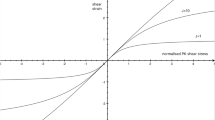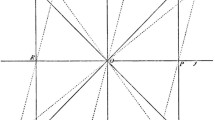Abstract
Active materials are media for which deformations can occur in absence of loads, given an external stimulus. Two approaches to the modeling of such materials are mainly used in literature, both based on the introduction of a new tensor: an additive stress \(\mathsf{P}_{\text{act}}\) in the active stress case and a multiplicative strain \(\mathsf{F}_{a}\) in the active strain one. Aim of this paper is the comparison between the two approaches on simple shears.
Considering an incompressible and transversely isotropic material, we design constitutive relations for \(\mathsf{P}_{\text{act}}\) and \(\mathsf{F}_{a}\) so that they produce the same results for a uniaxial deformation along the symmetry axis. We then study the two approaches in the case of a simple shear deformation. In a hyperelastic setting, we show that the two approaches produce different stress components along a simple shear, unless some necessary conditions on the strain energy density are fulfilled. However, such conditions are very restrictive and rule out the usual elastic strain energy functionals. Active stress and active strain therefore produce different results in shear, even if they both fit uniaxial data.
Our results show that experimental data on the stress-stretch response on uniaxial deformations are not enough to establish which activation approach can capture better the mechanics of active materials. We conclude that other types of deformations, beyond the uniaxial one, should be taken into consideration in the modeling of such materials.








Similar content being viewed by others
References
Ambrosi, D., Pezzuto, S.: Active stress vs. active strain in mechanobiology: constitutive issues. J. Elast. 107, 199–212 (2012)
Ambrosi, D., Arioli, G., Nobile, F., Quarteroni, A.: Electromechanical coupling in cardiac dynamics: the active strain approach. SIAM J. Appl. Math. 71(2), 605–621 (2011)
Blemker, S.S., Pinsky, P.M., Delp, S.L.: A 3D model of muscle reveals the causes of nonuniform strains in the biceps brachii. J. Biomech. 38(4), 657–665 (2005)
Ehret, A.E., Böl, M., Itskov, M.: A continuum constitutive model for the active behaviour of skeletal muscle. J. Mech. Phys. Solids 59(3), 625–636 (2011)
Giantesio, G., Musesti, A.: A continuum model of skeletal muscle tissue with loss of activation. In: Gerisch, A., Penta, R., Lang, J. (eds.) Multiscale Models in Mechano and Tumor Biology: Modeling, Homogenization, and Applications. Lecture Notes in Computational Science and Engineering, vol. 122, pp. 139–159. Springer, Berlin (2017)
Giantesio, G., Musesti, A.: Strain-dependent internal parameters in hyperelastic biological materials. Int. J. Non-Linear Mech. 95, 162–167 (2017)
Giantesio, G., Marzocchi, A., Musesti, A.: Loss of mass and performance in skeletal muscle tissue: a continuum model. Commun. Appl. Ind. Math. 9(1), 1–19 (2018)
Hawkins, D., Bey, M.: A comprehensive approach for studying muscle-tendon mechanics. ASME J. Biomech. Eng. 116, 51–55 (1994)
Heidlauf, T., Röhrle, O.: Modeling the chemoelectromechanical behavior of skeletal muscle using the parallel open-source software library OpenCMISS. Comput. Math. Methods Med. 2013, 1–14 (2013)
Heidlauf, T., Röhrle, O.: On the treatment of active behaviour in continuum muscle mechanics. PAMM 13(1), 71–72 (2013)
Heidlauf, T., Röhrle, O.: A multiscale chemo-electro-mechanical skeletal muscle model to analyze muscle contraction and force generation for different muscle fiber arrangements. Front. Physiol. 5, 498 (2014)
Hernández-Gascón, B., Grasa, J., Calvo, B., Rodríguez, J.: A 3D electro-mechanical continuum model for simulating skeletal muscle contraction. J. Theor. Biol. 335, 108–118 (2013)
Horgan, C.O., Murphy, J.G.: Simple shearing of soft biological tissues. Proc. R. Soc., Math. Phys. Eng. Sci. 467, 760–777 (2011)
Kondaurov, V.I., Nikitin, L.V.: Finite strains of viscoelastic muscle tissue. J. Appl. Math. Mech. 51(3), 346–353 (1987)
Martins, J., Pires, E., Salvado, R., Dinis, P.: A numerical model of passive and active behavior of skeletal muscles. Comput. Methods Appl. Mech. Eng. 151(3–4), 419–433 (1998)
Morrow, D.A., Donahue, T.L.H., Odegard, G.M., Kaufman, K.R.: Transversely isotropic tensile material properties of skeletal muscle tissue. J. Mech. Behav. Biomed. Mater. 3(1), 124–129 (2010)
Nardinocchi, P., Teresi, L.: On the active response of soft living tissues. J. Elast. 88(1), 27–39 (2007)
Neff, P.: Some results concerning the mathematical treatment of finite plasticity. In: Deformation and Failure in Metallic Materials, pp. 251–274. Springer, Berlin (2003)
Odegard, G.M., Haut Donahue, T.L., Morrow, D.A., Kaufman, K.R.: Constitutive modeling of skeletal muscle tissue with an explicit strain-energy function. J. Biomech. Eng. 130, 061017 (2008)
Paetsch, C., Dorfmann, L.: Stability of active muscle tissue. J. Eng. Math. 95(1), 193–216 (2015)
Pathmanathan, P., Chapman, S.J., Gavaghan, D.J., Whiteley, J.P.: Cardiac electromechanics: the effect of contraction model on the mathematical problem and accuracy of the numerical scheme. Q. J. Mech. Appl. Math. 63(3), 375 (2010)
Pezzuto, S., Ambrosi, D., Quarteroni, A.: An orthotropic active-strain model for the myocardium mechanics and its numerical approximation. Eur. J. Mech. A, Solids 48, 83–96 (2014)
Rossi, S., Ruiz-Baier, R., Pavarino, L.F., Quarteroni, A.: Orthotropic active strain models for the numerical simulation of cardiac biomechanics. Int. J. Numer. Methods Biomed. Eng. 28(6–7), 761–788 (2012)
Taber, L.A., Perucchio, R.: Modeling heart development. J. Elast. 61(1), 165–197 (2000)
Weickenmeier, J., Itskov, M., Mazza, E., Jabareen, M.: A physically motivated constitutive model for 3D numerical simulation of skeletal muscles. Int. J. Numer. Methods Biomed. Eng. 30(5), 545–562 (2014)
Wilkie, D.R.: The mechanical properties of muscle. Br. Med. Bull. 12(3), 177–182 (1956)
Acknowledgements
The authors thank the anonymous reviewers for their comments and suggestions.
This work has been partially supported by National Group of Mathematical Physics (GNFM-INdAM).
Author information
Authors and Affiliations
Corresponding author
Additional information
Publisher’s Note
Springer Nature remains neutral with regard to jurisdictional claims in published maps and institutional affiliations.
Rights and permissions
About this article
Cite this article
Giantesio, G., Musesti, A. & Riccobelli, D. A Comparison Between Active Strain and Active Stress in Transversely Isotropic Hyperelastic Materials. J Elast 137, 63–82 (2019). https://doi.org/10.1007/s10659-018-9708-z
Received:
Published:
Issue Date:
DOI: https://doi.org/10.1007/s10659-018-9708-z




